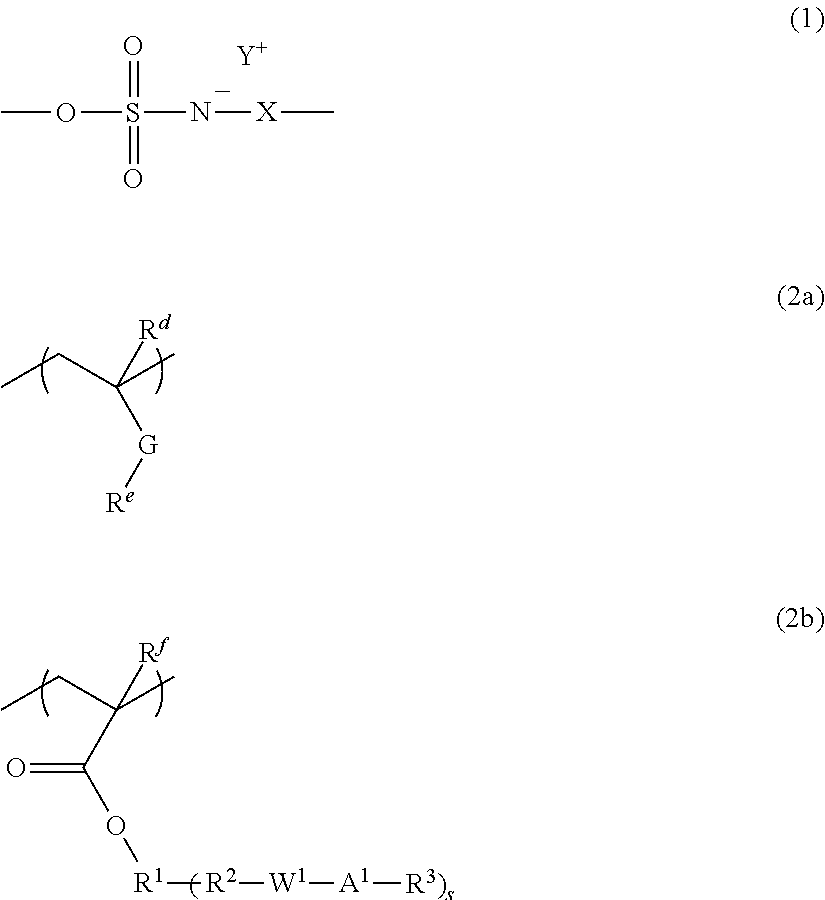Radiation-sensitive resin composition and resist pattern-forming method
a technology of radiation-sensitive resin and composition, which is applied in the direction of photomechanical equipment, microlithography exposure equipment, instruments, etc., can solve the problems of resist pattern development defects, storage stability degradation, and conventional radiation-sensitive resin compositions that have not been able to meet these demands, etc., to reduce lwr and cdu, less development defects, and increase the effect of resolving ability
- Summary
- Abstract
- Description
- Claims
- Application Information
AI Technical Summary
Benefits of technology
Problems solved by technology
Method used
Image
Examples
synthesis example 1
[0300]A compound represented by the following formula (A′-1) (40 mmol) was dissolved in water, and the mixture was stirred for 30 min. To this was added an aqueous solution of a compound represented by the following formula (A′-2) (30 mmol), and the mixture was stirred for 1.5 hrs. To the reaction liquid was added 500 g of methylene chloride, and the mixture was further stirred for 1 hour. Then, the methylene chloride layer was recovered, and washed five times with 500 g of water. Thereafter, methylene chloride was distilled off under reduced pressure, and drying was carried out to obtain a compound represented by the following formula (A-1).
[0301]
[0302]The results of the 1H-NMR measurement of the compound (A-1) obtained are shown below. It is to be noted that a sample for the measurement was prepared by dissolving the obtained compound (A-1) (0.03 mmol) in deuterated dimethyl sulfoxide (1.0 mL).
[0303]1H-NMR (400 MHz; solvent: DMSO-d6; internal standard: TMS): δ (ppm): 7.75-7.90 (15...
synthesis examples 2 and 3
[0305]A compound represented by the following formula (A-2) and a compound represented by the following formula (A-3) were synthesized in a similar manner to Synthesis Example 1 described above.
[0306]
Synthesis of Polymers
[0307]Compounds used in the synthesis of the fluorine atom-containing polymer (B) and the polymer (E) are shown below.
[0308]
synthesis example 4
r (B-1)
[0309]The compound (M-6) in an amount of 2.63 g (30 mol %) and the compound (M-11) in an amount of 7.37 g (70 mol %) were dissolved in 20 g of 2-butanone, and 0.59 g of 2,2′-azobis(2-isobutyronitrile) (8 mol % with respect to the total amount of the compounds) was further charged into a 200 mL three-neck flask. After nitrogen-purging was carried out for 30 min, the reaction vessel was heated to 80° C. with stirring, whereby the polymerization reaction was allowed to proceed for 6 hrs, in which the time of the start of the heating was regarded as the time of the start of the polymerization reaction. After the completion of the polymerization, the polymerization reaction liquid was cooled to 30° C. or below through water-cooling, and concentrated under reduced pressure in an evaporator until the mass of the polymerization reaction liquid was reduced to 15 g. The obtained concentrated liquid was slowly charged into 200 g of n-hexane cooled to 0° C. to permit the solid content to...
PUM
| Property | Measurement | Unit |
|---|---|---|
| temperature | aaaaa | aaaaa |
| temperature | aaaaa | aaaaa |
| pore size | aaaaa | aaaaa |
Abstract
Description
Claims
Application Information
 Login to View More
Login to View More - R&D
- Intellectual Property
- Life Sciences
- Materials
- Tech Scout
- Unparalleled Data Quality
- Higher Quality Content
- 60% Fewer Hallucinations
Browse by: Latest US Patents, China's latest patents, Technical Efficacy Thesaurus, Application Domain, Technology Topic, Popular Technical Reports.
© 2025 PatSnap. All rights reserved.Legal|Privacy policy|Modern Slavery Act Transparency Statement|Sitemap|About US| Contact US: help@patsnap.com



